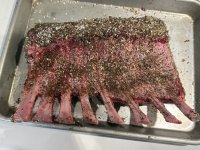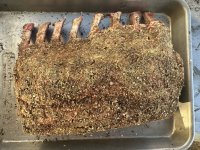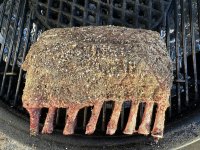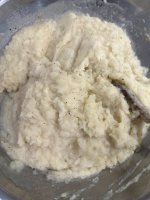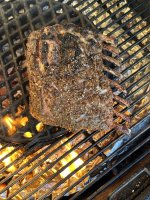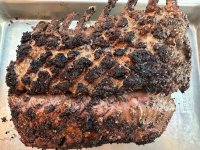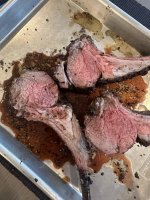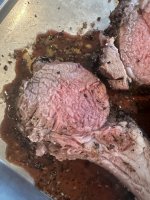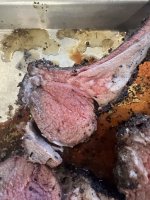You are using an out of date browser. It may not display this or other websites correctly.
You should upgrade or use an alternative browser.
You should upgrade or use an alternative browser.
Rack of lamb and mashed pots
- Thread starter Brett-EDH
- Start date
Tim Campbell
TVWBB Diamond Member
Nice work, Brett
Jeff Boudman
TVWBB Wizard
Looking mighty fine!
Timothy F. Lewis
TVWBB 1-Star Olympian
Another fine rack of lamb!!
Timothy F. Lewis
TVWBB 1-Star Olympian
Brett, you always seem to get the racks to that state of excellence of medium rareness! What sort of timing are you doing? Quick sear then indirect is what it looks like temp to what? I don’t do them often enough anymore to have the “eye” for getting it right, I need more practice again but, yours are so pretty!
Bruno
TVWBB Hall of Fame
Probably because it’s always salt, pepper, garlic, maybe some Aleppo pepper if he wanted some color.How come I am usually the only one that wants to know what goes on the meat?
Brett, is he right?Probably because it’s always salt, pepper, garlic, maybe some Aleppo pepper if he wanted some color.

Brett-EDH
TVWBB Olympian
SPG, allspice, celery seed, ground coriander, thyme, rubbed sage. No measurements as I sprinkled all spices to visual desiredness.How come I am usually the only one that wants to know what goes on the meat?
I basically walked through my spice drawer for the earthy profile I was seeking to go with lamb.
The mashed pots were cooked in chicken stock and then hand mashed and added in unsalted butter. Then I added around 1.5 cups of the cooked chicken stock to the potatoes to get the smoothness I was seeking.
Bruno
TVWBB Hall of Fame
I was just kidding mostly. I know Brett like Aleppo.Bruno, DH saw your post and had me put Aleppo pepper on the shopping list.
You’re the best Joan, good luck with it.
My oldest son and I are trying to cook as much Mediterranean as we can.
Brett’s pork souvlaki was a huge hit.
Brett-EDH
TVWBB Olympian
It’s a little easier than you think.Brett, you always seem to get the racks to that state of excellence of medium rareness! What sort of timing are you doing? Quick sear then indirect is what it looks like temp to what? I don’t do them often enough anymore to have the “eye” for getting it right, I need more practice again but, yours are so pretty!
Dry rub and let the rack rest for 20-30 minutes.
Place on hot grill indirect location for 10-15 minutes. This is the main cook.
Your temp will get to 105° or so from that 15 mins. Make the 100-105° your target.
Next comes the dance. You cannot leave lamb in direct heat over coals. Too much fat will drip and you’ll be in inferno mode.
You have to flip, move and rotate the lamb rack. Sometimes I have to pull it off completely and close the lid to extinguish the fat fire. It basically always happens.
So starting with a clean grill is important so you reduce the risk of grease fires.
You also have to cook the frenched bones too. But you cannot leaves the bones over direct heat for too long as they’ll singe off.
So you’re dancing the lamb around the grate and then probing with an instant read thermometer in the thickest part of the rack.
I like to goto 125° and then rest the lamb in a tray tented so the temp rises a little and the juices settle. I prefer a 10-15 minute rest.
In the prep portion of the rack, I highly recommend you score the fat cap. That helps the seasonings penetrate and for the fat to render and crisp up some. You have to cook the fat on rack of lamb. It adds massive flavor to the finished rack.
Timothy F. Lewis
TVWBB 1-Star Olympian
Thanks, that’s pretty much the way I used to do them but, since I’m the real lamb fan here and I should not scarf down an entire rack by myself I don’t get the opportunity to cook them very often. I will be having some friends who love lamb for some shanks next weekend and another friend who I owe a nice dinner of martinis and lamb for watching our cat when we were at the lake! That’s a couple of weeks out but, I like thinking ahead and getting a mental plan!It’s a little easier than you think.
Dry rub and let the rack rest for 20-30 minutes.
Place on hot grill indirect location for 10-15 minutes. This is the main cook.
Your temp will get to 105° or so from that 15 mins. Make the 100-105° your target.
Next comes the dance. You cannot leave lamb in direct heat over coals. Too much fat will drip and you’ll be in inferno mode.
You have to flip, move and rotate the lamb rack. Sometimes I have to pull it off completely and close the lid to extinguish the fat fire. It basically always happens.
So starting with a clean grill is important so you reduce the risk of grease fires.
You also have to cook the frenched bones too. But you cannot leaves the bones over direct heat for too long as they’ll singe off.
So you’re dancing the lamb around the grate and then probing with an instant read thermometer in the thickest part of the rack.
I like to goto 125° and then rest the lamb in a tray tented so the temp rises a little and the juices settle. I prefer a 10-15 minute rest.
In the prep portion of the rack, I highly recommend you score the fat cap. That helps the seasonings penetrate and for the fat to render and crisp up some. You have to cook the fat on rack of lamb. It adds massive flavor to the finished rack.
Thanks again!

